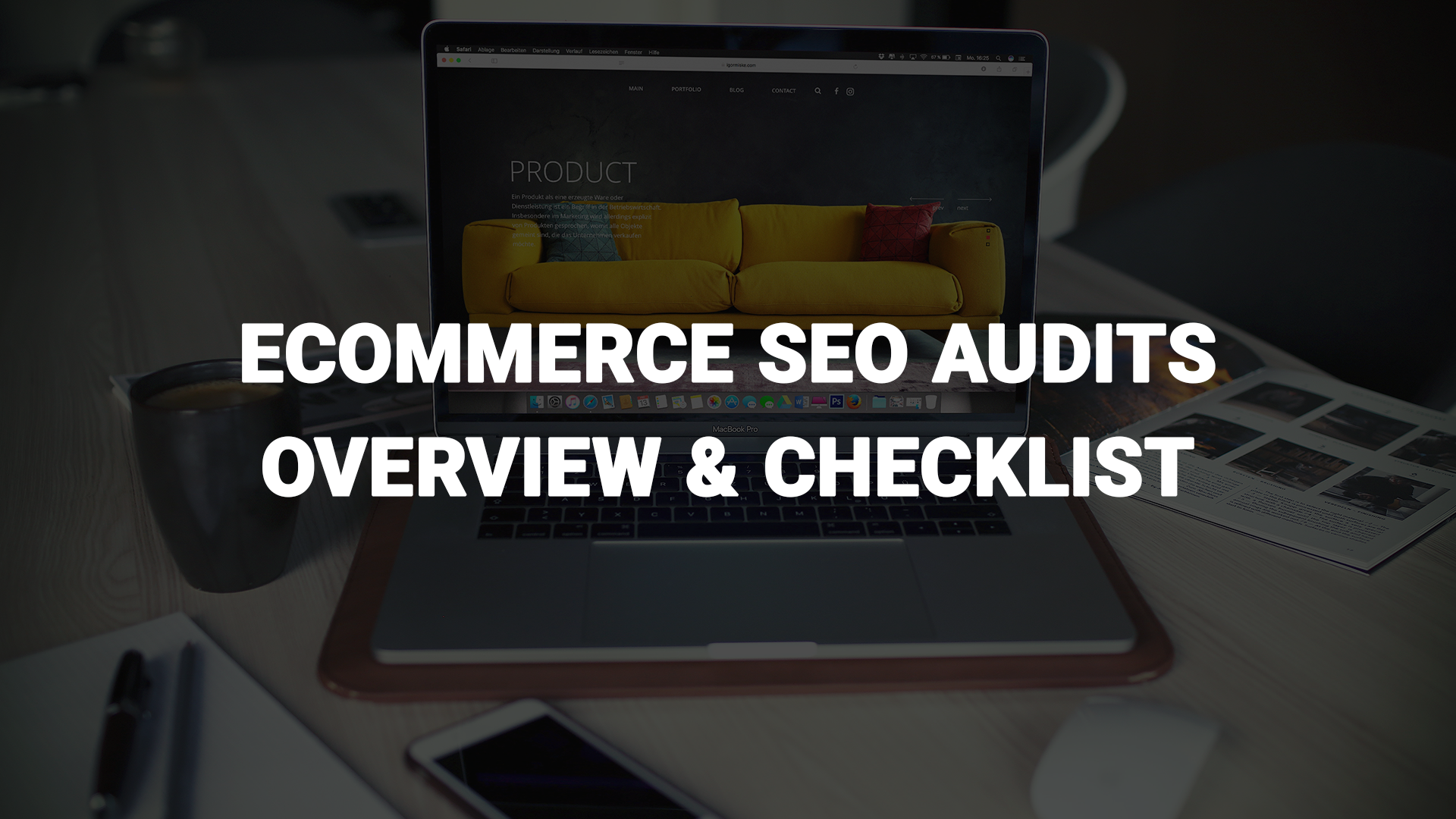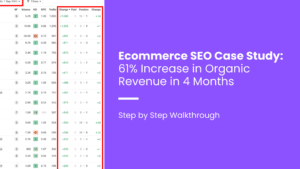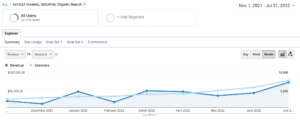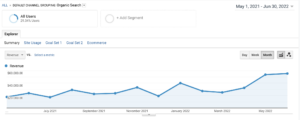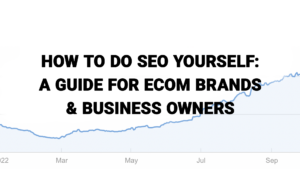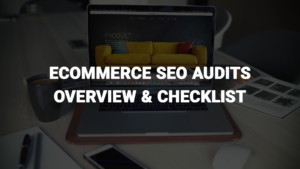If you have an eCommerce brand you’ve likely considered investing in several marketing channels, including SEO, also known as Search Engine Optimization. Before you fully commit to an SEO retainer with an agency or a consultant, you can also explore the SEO needs of your eCommerce website with an SEO audit.
An SEO audit can give you a behind-the-scenes look at the pain points your website is facing and ideally should provide you with a roadmap for addressing those issues and improving your organic search traffic. An audit can be the perfect way to understand the level of investment your website needs to ensure you aren’t investing too little or too much.
What is an Ecommerce SEO Audit?
An eCommerce SEO audit tends to focus on four main areas of SEO. These tend to include the technical SEO issues your website is facing, keyword research, content, and backlinks. Uncovering issues and opportunities in these four areas will give you a full picture of how you can better optimize your website.
SEOs will use a wide range of tools including Google Search Console, Ahrefs, Google Analytics, and Screaming Frog to dig into the problems affecting your eCommerce site and develop an SEO strategy for your brand.
What Does an SEO Audit Include?
When you receive your SEO audit, you should have access to the following:
The data pulled in the audit process
Spreadsheets from the Keyword Research Audit and Technical SEO Audit
Additional Insights from the Backlink and Content Audit portions of the SEO Audit
A video walkthrough or a one-on-one walkthrough with your SEO agency or consultant
A full list of recommendations and next steps
What is Not Included in the Audit?
Typically, an SEO Audit will give you recommendations on what to do, but won’t necessarily instruct you step-by-step on how to remedy the issues or take advantage of the opportunities. The main goal of the audit is to provide you with a roadmap that you can use with your in-house team or with an SEO agency or consultant to improve your traffic, rankings, and sales.
How often should you audit your eCommerce website?
How often you audit your website depends on if you’re working with an agency or a consultant or just working on the website yourself. An agency or consultant will usually monitor and stay on top of the technical issues, and will consistently build new backlinks and content. The initial audit they produce will help map out the overall plan of action, but an agency or consultant will use SEO-specific tools to monitor and audit the website on a regular basis.
Since SEO is an ever-changing channel, a big, comprehensive audit once a year can be helpful, but outside of that, working directly with an agency or consultant should help keep you on top of any new issues. Certain SEO elements, such as meta title tags and meta descriptions can be tweaked regularly to find the right formula for success.
Are SEO Audits Worth It?
Even if an SEO audit only uncovers one major issue on your website, it could be worth tens of thousands of dollars or more! Whether it’s uncovering a crawling or indexing issue that’s keeping your website pages from showing up on Google or a comprehensive list of direct action items you can address on some of your most important pages, an SEO audit will give you the information you need to improve your rankings, earn more traffic, and better align your website to increase revenue from SEO.
Alternatively, if you run your own marketing agency or consulting business, working with a white label partner for your SEO Audits can be a great way to expand your service offering and increase the LTV of your clients.
How Much Does an SEO Audit Cost?
Many SEO agencies and consultants charge a one-time flat fee for an SEO audit. The cost can vary greatly depending on the number of pages on your website. Typically, you should expect to spend $2,000 to $5,000 for an audit and if you have a larger website, expect to spend even more.
Ecommerce SEO Audit Checklist:
In need of an SEO audit and want to make sure you’re getting everything you need to take your website to the next level? Here’s a comprehensive eCommerce SEO audit checklist you can use to make sure you’re working with an agency or consultant that is covering all of the bases for your website.
Technical SEO Audit Checklist
The technical portion of the SEO audit digs into what is sometimes referred to as the backend of your website. These are items that could be affecting your website’s ability to show up on Google or other search engines or affecting the efficiency of how your website loads and the overall user experience a user might have.
These are crucial items to resolve as some of the issues may make it more or less impossible to find your website.
A few key items you should make sure are covered in your Technical SEO Audit:
Crawlable and Indexable
This first item is the most important item on this list. Is your website crawlable by Google and other search engine bots and are your pages indexable on Google itself? If your site cannot be crawled and indexed, it won’t show up in ANY search online. In some cases, even submitting an XML sitemap to Google Search Console can help make your website easier to crawl and index.
Response Codes
Response or status codes are codes a server sends out to note how the server handled a page request. Ideally, you want your pages to have a status code of 200, meaning it was served directly and successfully. While there are many status codes your server might send out, the most important one to resolve is the 404. A 404 status code lets you know that a page could not be reached or doesn’t exist. You’ll want to 301 redirect some of your 404s to more appropriate pages so users can successfully find the content they are looking for.
Canonicals
Canonical tags are tags placed in the code of your website pages. They inform Google which page you want to index on Google. In most cases, pages will have a “self-referencing” canonical tag.
For eCommerce websites, canonicals are often used on product variations to inform Google of which product URL is the main product page and which product URLs are variations. The product variant URLs should have canonicals that reference the non-variant URL.Crawl Depth
Crawl depth refers to how many clicks it takes to get to a piece of content on your website. The more clicks, the harder it is for people to access the content and the less likely they will be to find and read that content. Additionally, this also makes it harder for Google and other search engines to crawl and reach these pages. Ideally, you want your most important pages to be at most, 3 to 4 clicks away from your homepage.
Site Architecture
Site architecture refers to how the navigation of your website is organized and how you’ve organized the internal links across your website. The architecture will help lay out a hierarchy of the different subjects your website covers and when organized correctly, will make it easy for users and Google to understand what topics your website covers and how these topics are related to each other. Your site architecture is also documented by the XML sitemap of your website, which communicates the different types of indexable items you have on your website. Whether that includes pages, blog posts, media files, products, and product categories.
Page Speed
Page speed is one of the most important technical SEO issues you can address on your website. People do not have patience much these days, especially not slow websites. Smartphones have made people accustomed to getting the information they want immediately. Because of this, page speed is a crucial issue to resolve. If your website is slow to load, users will return back to Google to find a website that loads faster. If this user behavior is monitored by Google often enough, it can also negatively affect your rankings.
Unnecessary 301 redirects
301 Redirects can be a useful tool for resolving 404 errors or URL changes on your website. Over a long enough time though, these redirects can add up and slow down how fast a server can load and deliver your website, create redirect chains, or affect the power of your internal links.
Proper Use of the NoIndex Tag
The “noindex” tag is a tag that can be added to the code on a page that tells Google and other search engines not to index a page. There are many use cases where you should use a noindex tag, but you don’t want to noindex pages that you want to be found on Google.
Orphan Pages
An orphan page is a page that is not in your website’s navigation and has no internal links pointing to it. This makes it an orphan! The page exists, but there isn’t a parent page linking to it, making it hard to crawl and be found.
Keyword Research Audit Checklist
The keyword research part of your SEO audit should help you better understand what keywords your website is currently ranking for, what keywords you should focus on improving first, what keywords your competitors are ranking for, and how you can use this keyword data to inform your content strategy.
Some items keyword research should dive into include:
Primary keywords
Primary keywords are the most important or most relevant keywords your website ranks for. It can be helpful to tie these keywords to specific pages so you have a clear understanding of the most important keyword for each page. This will provide more direction for your team when it comes to optimizing your website pages.
Secondary keywords
Secondary keywords are keywords that are important to your website, but either doesn’t have a primary page or need a primary page created for them. These keywords can be valuable to include in content as supporting topics to their primary counterparts or for discovering new content ideas.
Low-hanging fruit
Low-hanging fruit refers to keywords your website ranks well or decently for but hasn’t hit the #1 ranking yet. These keywords can provide you with easy optimization wins, as addressing issues related to these keywords and pages can give your website almost instant wins in rankings, traffic, and revenue.
Searcher Intent
Searcher intent refers to understanding what a searcher is hoping to find when they type a specific keyword into Google. Depending on the keyword phrase they use when searching, they may be looking for informational content, comparison content, or looking to buy. Understanding the intent of your keywords can help you better organize your content efforts and optimization priorities.
Content clusters
Content clusters can help you understand the larger themes across your keywords and website content. By understanding these clusters you can find content areas that could use more content or content areas that you haven’t written on at all, but are ranking for. Those rankings will likely be on page 5 or lower on Google but could be a signal your website has the ability to rank well for these keywords, even though you haven’t specifically created content aimed at doing so.
Content or On-Page SEO Audit Checklist
A Content Audit is sometimes referred to as an On-Page SEO audit and dives into the factors found directly on your website pages that could be affecting how the pages are ranking and what they are ranking for.
Meta titles and descriptions
The meta or page titles and meta descriptions are tags you can add to your website pages that can include relevant keywords your page discusses or is aiming to rank for. These tags show up directly on Google searches and when optimized correctly can help your website rank higher and influence clicks to your website.
Duplicate content
Using the same content over and over again across multiple pages of your website is a big no. It’s not helpful to your users and makes it hard for Google to understand which page on your website should be delivered to users and makes it look like your website doesn’t provide unique or specific value across all of your website pages.
Broken links
If you add a link on your website it should go somewhere that actually exists. If a link on your website links to a page that no longer exists, that is referred to as a broken link and should be resolved.
Thin content
There have been numerous studies that show in-depth and lengthy content ranks very well on Google. This is why so many SEOs focus on word count when they are creating content. While you don’t want to add fluff to your website pages just to hit a word count target, pages with less than 300 words are often flagged as thin and should be expanded upon to show true authority and expertise on the subject.
Keyword cannibalization
As mentioned in our keyword research part of this post, primary keywords should be tied to specific pages on your website. It’s important though that a keyword is a primary keyword for only one page. If you try to rank multiple pages for the same keyword, Google will have trouble understanding which page to rank for that keyword and wind up trying to rank all of them. This often creates fluctuating keyword rankings and keeps the correct page for that keyword from ranking as high as it should be.
Internal linking
Internal linking is when you add a link from one page to another on your website. These internal links can be enriched by using keyword-specific anchor text within your content to help connect different topics and ideas. Pages lacking internal links will often struggle to rank, so auditing your internal links can help you uncover optimization opportunities.
Cooke-cutter content
Cookie-cutter content is content that is formulaic and doesn’t provide much value to your website. This often requires a manual review of your content and needs to be compared to the quality of competing pages. In order to stand out on Google, your content needs to be unique and provide direct value to searchers.
CTR
CTR or click-thru rate is the percentage of time that a searcher clicks on a Google search result for one of your website pages. For example, if a page on your website had 100 impressions on Google, but only had 1 click to the page, it would have a CTR of 1%. This data is best found in Google Search Console. Understanding which pages have a low CTR can help you drive more traffic to your website.
Low-value content
If you have content that isn’t earning impressions, clicks or ranking well on Google, it might just be low-value content. These pages should be in consideration for being deleted from your website so it is easier for Google to crawl important and valuable pages on your website.
Backlink Audit Checklist
Backlinks are when another website links to your website. They act as a vote of confidence in the eyes of Google and are one of the most important ranking signals for your website. The strategy for acquiring backlinks needs to be managed carefully, as you don’t want to use any tactics that could negatively impact your website rankings.
How many Root Domains
In your eCommerce SEO audit, your agency should determine how many RDs or Root Domains your website currently has links from. This will help understand how many unique websites are linking to you.
Total Backlinks
The total number of backlinks you have will often be higher than the number of Root Domains and will inform your SEO consultant how many total links are pointing to your website.
Domain Rating
The domain rating or domain authority of your website, also known as DR and DA, is a third-party metric created by SEO tools like Ahrefs and MOZ that can help you understand how your website authority stacks up to competing websites. These metrics are on a 0 to 100 scale, with more authoritative websites, like the New York Times, having a 90 or higher DR, and less authoritative sites having a lower DR.
While it’s helpful to have as high of a DR as you can produce, you also need to understand what is realistic for your niche to help you set a realistic DR goal. It’s also important to understand that it is possible to outrank higher authority websites by better optimizing your content and website.Do-follow vs no-follow
There are also different types of backlinks that can point to your website. Primarily do-follow and no-follow links. Do-follow links are the most important, as they pass authority across websites. You’ll want to prioritize getting more do-follow links than your competitors. And while no-follow links do not pass authority, there are plenty of social and business listing websites that are worth having links on even though they offer no-follow links.
Comparing to competitors: total and quality
Your Backlink Audit should also uncover how you stack up to your competitors. Comparing metrics against your competitors will help you understand if you have an authority gap and how much effort it might require to close.
Anchor Text
Anchor text is the exact text or phrase that a link comes from. When mishandled, improperly used anchor text can negatively impact your website rankings or even get your website penalized. If you have a ranking issue, looking into anchor text can be helpful.
SEO Action Plan: What to do after the SEO Audit
Once your audit is complete, your SEO agency or consultant should provide you with an action plan. This action plan should have a list of items you can address from a technical, content, on-page, and backlink perspective. If you have an in-house team that can address some of these issues, you’ll have a clear roadmap to use to improve your rankings. If you don’t have an in-house team, you’ll have a better understanding of the investment you’ll need to make with the agency that conducted the audit or with another agency that can implement the recommendations.
Need an Ecommerce SEO Audit?
If you’re wondering if your eCommerce website could benefit from a fresh SEO Audit, the answer is YES! Noah Kain Consulting offers a comprehensive SEO Audit that digs into every aspect of SEO that might be holding your website back from ranking higher. Ready to get auditing? Contact us here.
